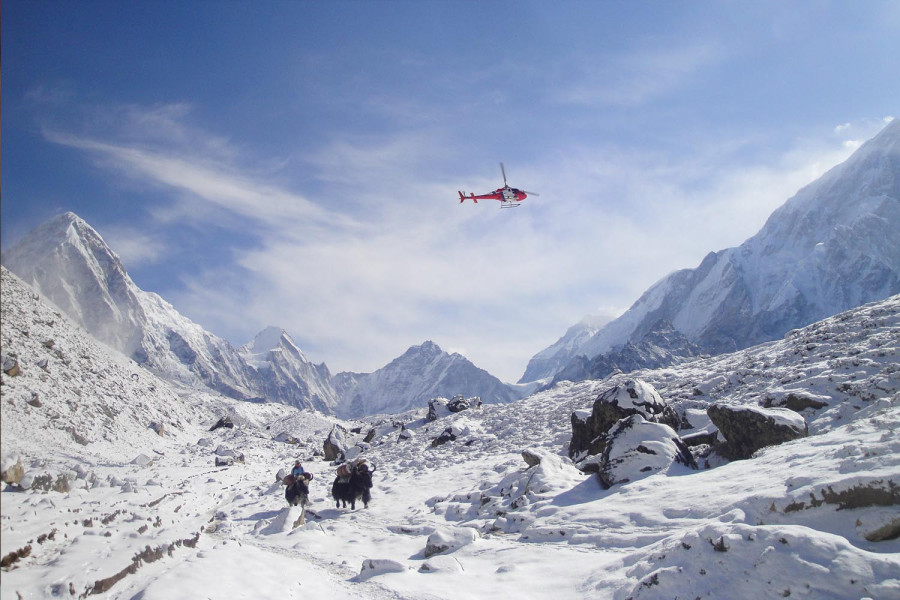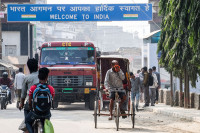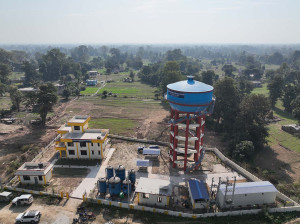Money
Local and federal governments lock horns over Everest chopper ban
National park’s decision to lift the ban on commercial flights has irked local officials.
Sangam Prasain
The debate over allowing helicopters to take tourists on sightseeing tours of Everest, the world’s tallest peak, is yet to be settled.
On December 12, the local municipality and the Sagarmatha National Park, home to the 8,848.86-metre mountain, issued directives restricting choppers from flying over the park on Everest sightseeing tours, starting January 1.
But on Monday, the national park reversed its earlier decision and allowed flights in the area after getting the park's permission.
“...All helicopter companies are requested to fly, land, and hover helicopters by the prevailing laws, ensuring no disturbance or harm to the park’s forest, wildlife and biodiversity, after obtaining permission from the park and paying the prescribed fees as per the rules,” the park office said in a statement.
Monday’s decision irked the Khumbu Pasang Lhamu Rural Municipality, the local government, complicating the matter. The rural municipality has been adamant about not allowing choppers and calls the park’s decision ‘unilateral.’
Since Tuesday, federal and local government officials, including the local youth clubs, have held marathon meetings following the national park’s statement, but they failed to reach a logical conclusion.
Earlier, local youth clubs posted photos on social media platforms planting flags and staking claims over the helipads and other areas where choppers usually land. They have also indirectly threatened chopper companies.
“We could not take any decision on Wednesday,” said Laxman Adhikari, the chairman of ward 4 of Khumbu Pasang Lhamu Rural Municipality.
“Wednesday’s meeting focused on rescue, commercial, sling, and mountain flights. Hopefully, the rural municipality will come up with its decision on Thursday,” he said.
Adhikari said resolution of this sensitive issue calls for consultations with conservationists and tourism experts.
According to an official of a chopper company, the rural municipality tried to strike a compromise by allowing helicopter operators to fly in the Everest region, from Lukla to Kala Patthar (or the Everest base camp) and back, without landing.
The chopper companies must also pay charges for flying over the Everest region.
“However, we did not accept the proposal, saying it was risky,” said the official. Since January 1, the choppers have halted flights.
Pratap Jung Pandey, the first vice president of the Airlines Operators Association of Nepal, the trade body of the airline industry, said it’s risky to land even after the park gave its green light for flights in the Khumbu region. The park owns most of the region.
The national park, which covers an area of 1,148 square kilometres in the Solukhumbu district, was established on July 19, 1976. In 1979, in recognition of its superlative natural surroundings and unique culture, it was listed as a UNESCO World Heritage Site.
“We are businesses. We don’t want to mess things up. But banning sightseeing flights is not the solution. We admit there are environmental and noise pollution problems, but they should be solved in a win-win way,” said Pandey, the managing director of Kailash Helicopter Services.
The local youth groups in the Everest region have started a campaign “Preserve Sagarmatha National Park.”
“The increasing number of helicopter flights in the national park has reached unsustainable levels, threatening the fragile ecosystem and serenity of this UNESCO World Heritage Site,” said Sonam Dorji Sherpa, president of Ama Dambam Youth Club.
“Local authorities are working to limit helicopter operations to essential purposes—rescue missions and cargo transport. This is vital to ensure long-term preservation of our beloved mountains.”
He said the local clubs will accept whatever the Khumbu Pasang Lhamu Rural Municipality decides.
The park’s immediate concern is severe noise pollution caused by frequent helicopter flights over the area. Conservation officers said there are more than 6,000 chopper flights above the national park in the spring and autumn.
The noise, caused by low-flying choppers, disturbs not only schools and offices in the region, but also animals, which rely on the park’s relatively undisturbed natural environment.
“Excess noise can interfere with their feeding, breeding, and other behaviours,” Sushma Rana, senior conservation officer of the park, told the Post in a recent interview. She said noise pollution in the wildlife habitat has caused behavioural changes in animals.
“The sounds can make wild animals leave their habitats and run into the villages,” said Rana.
“The accidents involving animals like Himalayan tahr and Himalayan goral, a goat-antelope with a short tail and backwards-pointing horns, are rising. The animals jump off the cliffs in shock when choppers fly at low altitudes with big sounds.”
On the other hand, the tourism fraternity warned that the Everest sightseeing ban could harm Nepal’s high-end tourism.
The Everest sightseeing tour is a lifelong dream for many wealthy people with money but no time.
For choppers, restrictions are already there.
A $8,000 helicopter tour accommodates up to four people up to Lukla. However, only two people can fly from Lukla and land at Kala Patthar at 5,644 metres, just below the Everest base camp at 5,364 metres.
The choppers are allowed to fly over the base camp, but are not allowed to land there.
The helicopters, however, can fly back with four people onboard.
The local community, however, complained that choppers pick up trekkers on their return, which has snatched away local jobs.
Usually, it takes 14 days for trekkers to reach Everest base camp.
“But most of them, after reaching the base camp, return by helicopter—a 30-minute flight to Kathmandu,” said Sherpa, the youth club president. “They use their insurance to book choppers faking illness. They are fake rescues.”
“The chopper rides have taken away the jobs of porters and guides. They have also hurt the Everest region's tea houses and resort businesses,” said Sherpa.
Experts say there is a need to balance tourism and conservation and stop the ongoing tussle before it spirals out of control.




 11.12°C Kathmandu
11.12°C Kathmandu













